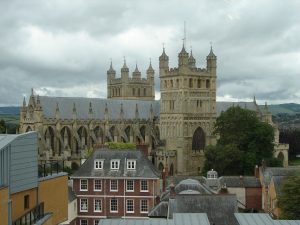 Earlier this year I have done postings on Exeter Cathedral (September 5) and its Minstrels’ Gallery (September 9) in which I have discussed the influence of the cathedral on my life and the inspiration it has given me in creating the Lady Apollonia West Country Mysteries. If you wish to see my September postings, click on https://blogs.valpo.edu/ellenfoster/2016/09/ . My last posting discussed the Cathedral Close. For the next few weeks I would like to do more postings on the topic of Exeter Cathedral which I knew and studied as a steward and tour guide during the four different years my husband and I lived in Exeter.
Earlier this year I have done postings on Exeter Cathedral (September 5) and its Minstrels’ Gallery (September 9) in which I have discussed the influence of the cathedral on my life and the inspiration it has given me in creating the Lady Apollonia West Country Mysteries. If you wish to see my September postings, click on https://blogs.valpo.edu/ellenfoster/2016/09/ . My last posting discussed the Cathedral Close. For the next few weeks I would like to do more postings on the topic of Exeter Cathedral which I knew and studied as a steward and tour guide during the four different years my husband and I lived in Exeter.
Exeter Cathedral has this status as a church because it has the throne or cathedra of the bishop of the local diocese. There are many dioceses in England and were fewer in number in medieval times. Not all great churches are cathedrals. In London, for example, Saint Paul’s is a cathedral while the great Westminster Abbey was originally a monastic church and is now a Royal Peculiar.
The exterior image screen on the west front of the cathedral is something that I wish to discuss in some detail because two of its three registers of carvings had been completed when my heroine, the Lady Apollonia, visited the cathedral in Plague of a Green Man.
The architecture of the building is essentially English Decorated Gothic of the 13th and 14th centuries, but certain parts are more ancient. The side towers had been built for the original Norman cathedral and were incorporated into the Gothic building, as was the outline of the nave whose walls are Norman up to the sills of the windows.
Tomb effigies in Exeter Cathedral are important to my stories. A medieval knight’s effigy in the south aisle inspired me to visualise the first title in my series of medieval mysteries, Effigy of the Cloven Hoof. Another Exeter effigy was part of the inspiration for Memento Mori, the third book in the series. Yet another of the cathedral’s knight’s effigies in the north choir aisle which included the knight’s horse, inspired the memorial which the Lady Apollonia commissioned after the death of her son, Sir Alwan, in that story. The aristocratic effigies of the Earl of Devon, Hugh Courtenay and his duchess in the south transept of Exeter were helpful in providing information about the nobility’s dress in the late 14th century.
For more on Exeter Cathedral, click on
https://en.wikipedia.org/wiki/Exeter_Cathedral .
Tags: Chaucer's England, historical fiction, medieval mysteries